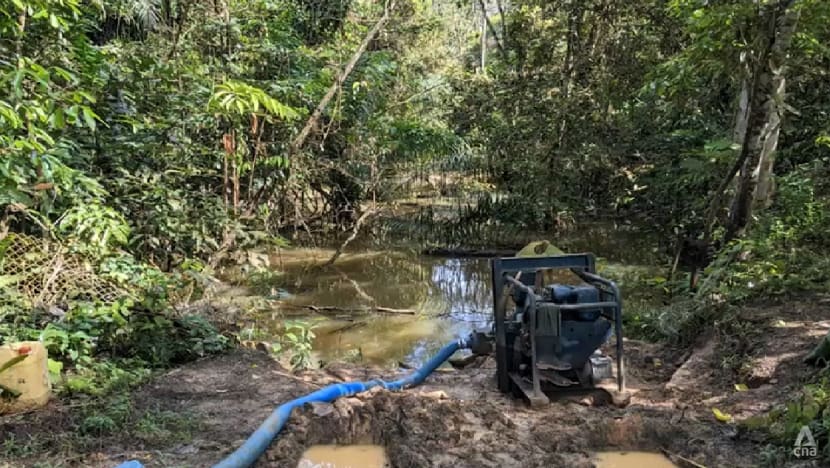Fallen trees, muddy waters: Cyclists concerned about flooded Bukit Timah bike trail amid bad weather
While only the flooded zone has been closed off, mountain bikers are avoiding the wider area due to the risk of falling trees.

NParks said it will have to carefully assess any plans given the possible impact to wildlife and nature. For now, it is pumping water out to alleviate the issue.
SINGAPORE: Fallen trees, muddy waters and the smell of decaying foliage greet visitors to a portion of Bukit Timah Mountain Bike Trail that has been waterlogged for months.
While authorities have closed off the flooded zone, mountain bikers are avoiding the wider area due to the risk of falling trees.
Observers are concerned that the perpetually-flooded stretch of mountain biking trail could pose a safety risk.
The National Parks Board (NParks) said it is closely monitoring the situation in the area, which floods naturally during heavy downpours. It added that waters usually subside within five days, depending on weather conditions.
When CNA visited the entrance of the route on Sunday (Jan 29), the water came up to ankle level.
Cyclists who frequent the trail said that the higher level of water continues for 500m, and even goes up to 1.5m in some parts. Fallen trees and debris also obstruct the route, they added.
SITUATION WORSE THAN OTHER YEARS
While this has happened during past monsoon seasons, this year’s flood situation is the worst they have experienced, the cyclists added.
The flooded zone is on the downhill side of the popular Bukit Timah Mountain Bike Trail, which sits next to the larger nature reserve.
A much-vaunted portion, also known as the Stairway to Heaven, is marked out for maintenance and has been closed for about four months. The 10m-high climb, right by the flooded zone, ends in a thrilling ride downhill.
There are also signs that warn mountain bikers of the danger and inform them of the alternative routes they can take.
Mountain bikers believe the drainage system there has become clogged.
“Due to the heavy usage, it forms a rut,” said Singapore Cycling Federation vice-president (Mountain Bike) Muhammad Faroz Marzoki. “People have been riding the same area over and over again, so it kind of erodes away the topsoil.
“So the topsoil has to go somewhere, so it's like slightly on the higher ground. With the rain and the natural flow of water, (this) has also significantly contributed to flooding.”
PROLONGED FLOODING COULD LOOSEN SOIL, UPROOT TREES
NParks said the problem is made worse because the old system has become misaligned due to sinking earth. The agency added that it will have to carefully assess any plans given the possible impact to wildlife and nature.
For now, it is pumping water out to alleviate the issue.
With dozens of pieces of feedback filed to the authorities on the problem, cyclists hope it is only a matter of time before they get back their adrenaline fix.
Mr Dominic Loh, vice-president of Publicity and Media at the Singapore Cycling Federation, said: “Singapore has very high rainfall. We have to really look at Bukit Timah as a whole and look at potential situations, and close sections that we need to do some mitigation work, and just close it for a period of time and let the repair team go in and let Mother Nature heal by itself.”
Highlighting the potential dangers, nature experts said prolonged flooding could loosen the soil over time and cause trees to be uprooted. There is also the chance of root rot occurring, they added.
“In the Amazon, you have parts of the forest there that might be underwater for months, a year and they are adapted to such conditions,” said Dr Shawn Lum, a senior lecturer at the Nanyang Technological University's Asian School of the Environment.
“Now, if you have a forest community that's not adapted to those conditions… if the water is a little bit higher than normal and stays for longer than normal, then you may see some of the plants gradually dying off.”
















